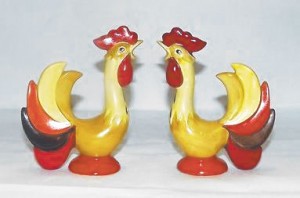As students at The University of Massachusetts in the early 1940s, they were inseparable. Unlike many of their classmates who were focused on football and frat parties, the Howard brothers and their best friend A. Grant Holt spent their college days planning and dreaming of the ceramics business they would start one day. But life after graduation sent them their separate ways and the dream seemed as though it would remain just that. John Howard went off to serve in World War II, Bob Howard went to Harvard where he earned a master’s degree in business and Grant Holt traveled to Sweden for his post-graduate work in design.
Inspired by his time in Sweden, Holt returned home with a plan to create a line of unique, whimsical ceramics. John and Robert were quick to jump on board and with loan of $9,000 from their parents, the three set about making their dream a reality. Bob Howard would serve as head of development, his brother John would be in charge of the sales department, and Grant would manage the financial end of the business. And so, Holt-Howard was formed in 1949.
For the first few years they focused on Christmas ceramics, but not the standard fare of the day. Their sharp sense of international trends sent their designs in a different direction than those that were common in the U.S. ceramics market to that point. Totally disenchanted with the decorations in their parent’s homes, the young people of mid-20th century America were captivated by the animated faces and atomic shapes of their ceramics. Holt-Howard had redefined Christmas decor and sales soared.
Early issues included the Winking Santa and Merry Whiskers beverage sets. Each year they would offer the sets in a new design, making they instantly collectible. Starry-eyed Santa party ware was also a hit. This line consisted of mugs, pitchers, salt and pepper shakers, candy dishes and ashtrays. Rounding out the early years of their Christmas line were a group of Christmas motif cookie jars. John Howard understood the importance of multiple pieces in the same pattern as a catalyst to repeat customers, assuring Howard-Holt’s success well into the 1970s.
In 1958 Holt-Howard issued a line of housewares with adorable little elf-like heads that is known as “Pixieware.” A strong favorite with collectors are the condiment jars from the Pixie line which were manufactured from 1958-1962. The first pieces to hit the market were the mustard, ketchup and jam and jelly jars with lids in the form of pixie heads. Each of these were individually packaged and were intended to be given as hostess gifts and holiday gift ware.
Cozy Cats, also released in 1958, were made in 13 different pieces including a cottage cheese crock, spice sets, condiment jars and a grease keeper. In this day of healthy eating it seems odd that people would actually collect and strain the grease after they made bacon and save it for later use, but the grease jar from this line was one of the most popular when it was released and remains popular with collectors today.
The housewives of the 1950s and 60s loved to decorate with roosters and Holt-Howard captured their imagination with the Exotic Rooster line. Unlike the other rooster patterns of the day, theirs had a slight French flair that set it apart from the competition. This dinnerware, the brain child of Bob Howard, and was sold at major department stores, including JC Penney’s, Macy’s and Bullocks. The ashtrays, vases and salt and pepper shakers from this line were issued in limited number and are considered a rare find.
With a renewed interest in the MCM period of American design, Holt-Howard ceramics are experiencing a rise in value. Watch for them as the summer estate sales wind down. Until next time . . . Linda
Linda Kennett is a professional liquidation consultant specializing in down-sizing for seniors and the valuation of estates and may be reached at 317-258-7835 or lkennett@indy.rr.com



